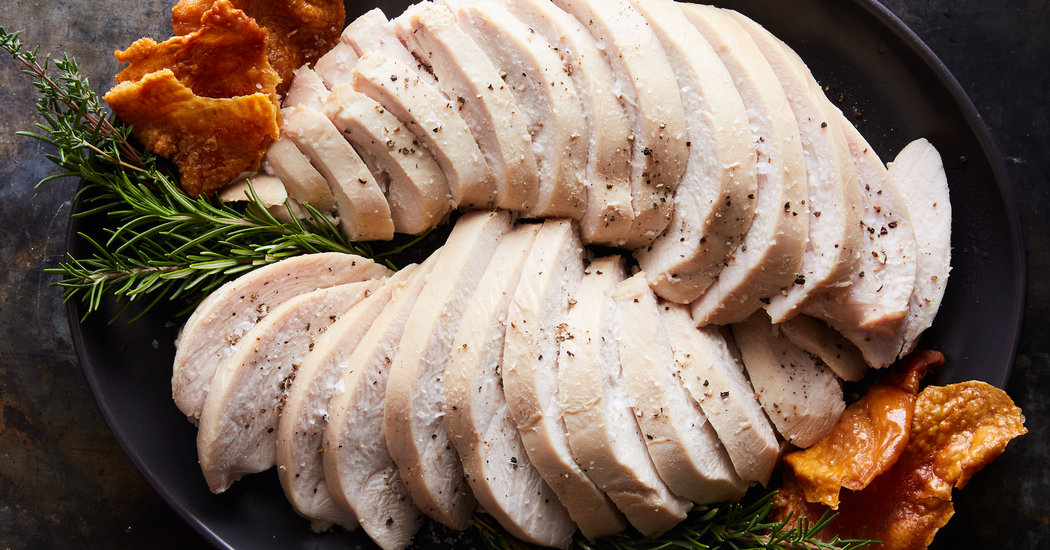
Picture any kitchen on Thanksgiving Day. There are dishes in the sink; every surface is covered with bowls, containers and cutting boards. In line for the oven are pies, turkey, casseroles and anything that needs reheating. On the burners, you’ve got gravy, cranberry sauce and mashed potatoes vying for space with the soup (whose idea was soup anyway?).
Then, imagine a tiny corner of calm amid the chaos. A sous-vide machine, maybe perched on a chair so as not to take up any precious counter space, is simultaneously cooking a turkey breast and reheating your mashed potatoes. It can make life easier on the home cook’s busiest day of the year.
If you have a sous-vide machine, you’re probably already versed in the delights of using it for steak, salmon, and ramen eggs with their silky, runny yolks.
Breaking it out on Thanksgiving is a holiday game changer. Not only will it cook a turkey breast conveniently and easily, but the results are better, juicier and more succulent and reliable than anything you can roast. And it does so conveniently and quietly, without adding to the already prodigious mess of the day.
But perhaps the greatest advantage to using sous vide to cook a turkey breast is that it eliminates one of the greatest Thanksgiving Day stresses, second only to wondering what your Great-Uncle Walter might say to stop the table conversation this year.
I speak of the piercing, meat thermometer-doubting anxiety of “did-I-over-or-undercook-the-turkey?”
Since white meat cooks faster than dark meat, the fear of drying out the breast meat is an annual reality. With sous vide, however, overcooking becomes impossible. The water will never get hotter than the temperature you set it to, which in my book should be 145 degrees for pink-tinged, tender morsels. In terms of food safety, 145 degrees is fine when using sous vide because the long, steady heat pasteurizes the meat.
Another benefit of sous vide is convenience. You can start your turkey breast in the morning and let it hang out there all day. Unlike traditionally roasted breast meat, it’s ready when you are, not the other way around.
Now, I’m not saying that sous-vide turkey breast should necessarily replace your roasted bird (and nothing beats those crispy, bronzed bits around the turkey tail and wings). But if you’re feeding a crowd and love leftovers, consider roasting a smaller whole turkey, and cooking an extra breast sous vide. Maneuvering a smaller bird in and out of the oven is less awkward than a 20-pounder, and it will roast more quickly, freeing up the coveted space for pie. Plus, a higher ratio of gorgeous, juicy breast meat means more sandwich-ready leftovers. (If you accidentally overcook the white meat of the roasted bird, it can still find a happy place in the soup pot.)
The only downside to sous vide poultry is soggy skin. I like to bake the turkey skin separately until it renders its fat and turns golden and crunchy. You can even do that on a baking sheet on the bottom of the oven while you reheat the green bean casserole.
Once you’ve taken your sous-vide machine out of its box, you can also use it ahead of time for mashed potatoes and brown sugar sweet potatoes, then reheat both of them at the same time in the same pot while your turkey breast cooks. Note that the thinner you slice your potatoes, the more quickly they will cook. And make sure to poke several at the end, so you know they are all done. (Err on the side of overcooking here.) Sous-vide potatoes can sometimes cook unevenly, and making sure they are all very tender is important for a smooth, silky purée.
Cooking a Thanksgiving meal can be as much of a yearly challenge as it is a joy. A sous-vide machine can lend a hand, in the most delectable way.
Recipes: Sous-Vide Turkey Breast With Maple and Rosemary | Sous-Vide Cheesy Mashed Potatoes | Sous-Vide Brown Sugar Sweet Potatoes With Pecans




